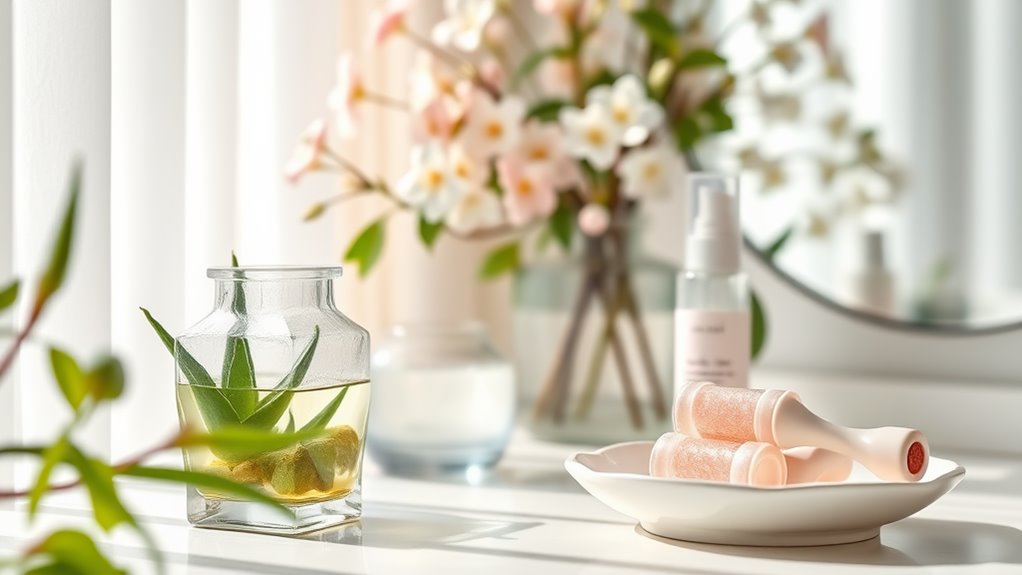Seasonal Skincare Swaps That Will Save Your Skin This Spring
As spring arrives, it’s crucial to reassess your skincare routine. The shift from winter’s heavy products to lighter alternatives can make a significant difference for your skin. You might be surprised at how simple swaps can enhance your complexion and overall skin health. From gel cleansers to airy moisturizers, the right choices can prepare your skin for warmer days ahead. Let’s explore what adjustments can best serve your skin this season.
Key Takeaways
- Transition to lightweight gel-based cleansers to effectively remove impurities without stripping moisture as temperatures rise in spring.
- Replace heavy winter moisturizers with hydrating gels or creams containing hyaluronic acid for better absorption and non-comedogenic benefits.
- Increase exfoliation frequency in spring to remove dead skin cells and enhance skin’s radiance and hydration.
- Incorporate broad-spectrum SPF 30 or higher into your daily routine to protect against UVA and UVB rays as sun exposure increases.
- Focus on key ingredients like Vitamin C and aloe vera to boost radiance and soothe skin during the seasonal shift.
Assessing Your Winter Skincare Routine
As the cold weather sets in, it’s imperative to assess your winter skincare routine to keep your skin healthy and hydrated.
Start by evaluating your cleansers; switch to cream or oil-based formulas that gently cleanse without stripping moisture.
Next, consider your serums and treatments; opt for those packed with hyaluronic acid or glycerin to boost hydration levels.
Don’t forget to upgrade your moisturizer to a richer, thicker cream that offers a protective barrier against harsh elements.
Exfoliation remains essential, but reduce frequency to avoid irritation.
Finally, incorporate a nourishing lip balm and hand cream into your routine; these are crucial for seasonal skincare. Additionally, enhancing your diet with antioxidant-packed fruits can further support your skin’s health from the inside out.
Mastering these adjustments guarantees your skin remains resilient and radiant throughout the winter months.
Lightweight Moisturizers for Spring
When spring arrives and temperatures begin to rise, it’s the perfect time to refresh your skincare routine with lightweight moisturizers.
Shifting from heavier formulations, look for gels or creams that absorb quickly and hydrate without weighing you down. Ingredients like hyaluronic acid and aloe vera provide essential moisture while maintaining a breathable feel on your skin. To enhance your hydration, consider incorporating fresh aloe vera gel into your routine, as it effectively calms irritated skin.
Choose non-comedogenic options to prevent clogged pores, especially as humidity increases. You might also consider moisturizers with added antioxidants to protect against environmental stressors.
Remember to apply your lightweight moisturizer after cleansing and toning for best absorption.
Embrace this season’s freshness by letting your skin breathe and thrive with a lighter touch, ensuring it remains radiant and balanced all spring long.
Exfoliation: A Springtime Essential
As spring arrives, your skin craves a fresh start, and exfoliation is key to achieving that glow.
By removing dead skin cells, you not only enhance your complexion but also boost the effectiveness of your other skincare products. Incorporating a triple-action facial scrub into your routine can simultaneously exfoliate, brighten, and moisturize your skin.
Let’s explore the best exfoliants to incorporate into your routine this season.
Benefits of Exfoliation
Exfoliation is an essential step in your spring skincare routine that can transform your complexion. By removing dead skin cells, you reveal fresher, brighter skin beneath, enhancing your natural glow.
This process not only unclogs pores but also boosts cellular turnover, helping to prevent breakouts and uneven texture. You’ll notice your skincare products absorb better, maximizing their effectiveness.
Regular exfoliation improves circulation, giving your skin a healthy, revitalized look. It also helps to fade dark spots and hyperpigmentation, promoting a more even skin tone.
Additionally, with the changing weather, exfoliating prepares your skin for better hydration, ensuring it remains smooth and supple.
Embrace exfoliation this spring, and elevate your skincare game to achieve that radiant springtime glow!
Best Spring Exfoliants
Spring calls for fresh starts, and choosing the right exfoliant can make all the difference in your skincare routine. As you shift from winter’s dryness, consider incorporating these top exfoliants to rejuvenate your skin:
| Exfoliant Type | Recommended Product |
|---|---|
| AHA (Glycolic Acid) | Paula’s Choice 8% AHA Gel |
| BHA (Salicylic Acid) | Neutrogena Oil-Free Acne Wash |
| Enzyme Exfoliant | Tatcha Rice Enzyme Powder |
| Physical Scrub | St. Ives Fresh Skin Apricot Scrub |
| Chemical Peel | Drunk Elephant TLC Sukari Babyfacial |
These options cater to various skin types and concerns. Regular exfoliation will help reveal brighter, smoother skin, enhancing your overall glow this season. Embrace these swaps for an effective spring skincare revival!
Switching to Gel-Based Cleansers
When the temperatures rise and humidity increases, switching to gel-based cleansers can make a significant difference in your skincare routine.
These lightweight formulas effectively remove dirt, oil, and impurities without stripping your skin of its natural moisture. Unlike cream cleansers, gel-based options provide a rejuvenating feel, making them ideal for warmer months.
They often contain hydrating ingredients like aloe vera or hyaluronic acid, which help maintain your skin’s balance. Look for gels that are non-comedogenic to prevent clogged pores, especially if you’re prone to breakouts. Additionally, incorporating apple cider vinegar into your routine can enhance your skin’s clarity and pH balance.
When applying, use gentle circular motions to enhance circulation and promote a healthy glow. Embrace this seasonal swap to achieve a clean, revitalized complexion that thrives in the springtime air.
Sun Protection: Choosing the Right SPF
When it comes to sun protection, choosing the right SPF can make all the difference.
You’ll find various types of SPF products, each designed for different needs, so it’s crucial to know what suits your skin best.
Plus, applying it correctly guarantees you get the maximum benefits, keeping your skin safe from harmful rays.
Types of SPF Products
Choosing the right SPF product can feel overwhelming, especially with so many options available. You’ll encounter chemical sunscreens, which absorb UV rays and prevent skin damage, and physical (mineral) sunscreens that sit on the skin and reflect rays.
Each type has its strengths: chemical formulas often blend seamlessly, while mineral options are ideal for sensitive skin.
Consider broad-spectrum products to protect against both UVA and UVB rays. Look for SPF 30 or higher for daily use.
Don’t forget tinted moisturizers or makeup with SPF for added protection. If you’re active, opt for water-resistant formulas.
Application Tips for Effectiveness
To guarantee your sunscreen works effectively, apply it generously and evenly to all exposed skin. Don’t skimp; a quarter-sized amount should cover your face alone. Reapply every two hours, or more often if you’re sweating or swimming. Remember to use broad-spectrum SPF 30 or higher for best protection.
Here’s a quick guide to enhance your sunscreen application:
| Application Tip | Details |
|---|---|
| Timing | Apply 15-30 minutes before sun exposure |
| Coverage | Don’t forget ears, neck, and scalp |
| Amount | 1 ounce for full body coverage |
| Reapplication Frequency | Every 2 hours or after swimming |
| Type | Choose water-resistant formulas for outdoor activities |
Master these tips for a solid defense against harmful UV rays this spring!
Incorporating Antioxidants Into Your Regimen
Incorporating antioxidants into your skincare regimen can greatly enhance your skin’s health and appearance.
These powerful compounds combat free radicals, reducing signs of aging and promoting a radiant complexion.
To get started, consider these four essential antioxidants:
-
Vitamin C: Brightens skin tone and boosts collagen production.
-
Vitamin E: Protects skin from environmental stressors while providing deep hydration.
-
Green Tea Extract: Offers anti-inflammatory benefits and soothes irritated skin.
-
Coenzyme Q10: Supports skin elasticity and reduces fine lines.
Additionally, antioxidants like vitamin C can also help to enhance natural skin radiance by neutralizing oxidative stress.
Hydrating Ingredients to Embrace This Season
As the seasons change and temperatures drop, your skin craves extra hydration to stay plump and radiant. Embrace ingredients that not only quench your skin’s thirst but also enhance its overall health. Here are some key hydrating components to evaluate:
| Ingredient | Benefits |
|---|---|
| Hyaluronic Acid | Holds 1000x its weight in moisture |
| Glycerin | Attracts water to the skin’s surface |
| Aloe Vera | Soothes and hydrates simultaneously |
| Squalane | Mimics natural oils for deep moisture |
| Ceramides | Strengthens the skin barrier |
Incorporating these ingredients into your routine will provide your skin with the hydration it needs to thrive this spring. Don’t underestimate the power of proper hydration—your skin will thank you!
Frequently Asked Questions
How Often Should I Change My Skincare Products With the Seasons?
You should change your skincare products with the seasons, ideally every three months. This keeps your routine aligned with your skin’s evolving needs, ensuring it stays balanced, hydrated, and protected against environmental changes.
Can I Use My Winter Products During Spring?
You can use your winter products in spring, but they might not suit the changing weather. Evaluate your skin’s needs and consider lighter, hydrating alternatives to maintain balance and prevent potential issues as temperatures rise.
Are There Specific Ingredients to Avoid in Spring?
You should avoid heavy oils and occlusive ingredients in spring, as they can clog pores and lead to breakouts. Instead, focus on lighter, hydrating formulas to keep your skin balanced and fresh during warmer months.
How Do Environmental Changes Affect My Skin in Spring?
Environmental changes in spring can trigger increased humidity and allergens, affecting your skin’s hydration and sensitivity. You’ll notice changes in oil production, which may require you to adjust your skincare routine for ideal balance and protection.
When Should I Start Applying Sunscreen in Spring?
You should start applying sunscreen as soon as temperatures rise and the sun’s intensity increases in spring. Even on cloudy days, UV rays can damage your skin, so make it a daily habit from now on.

